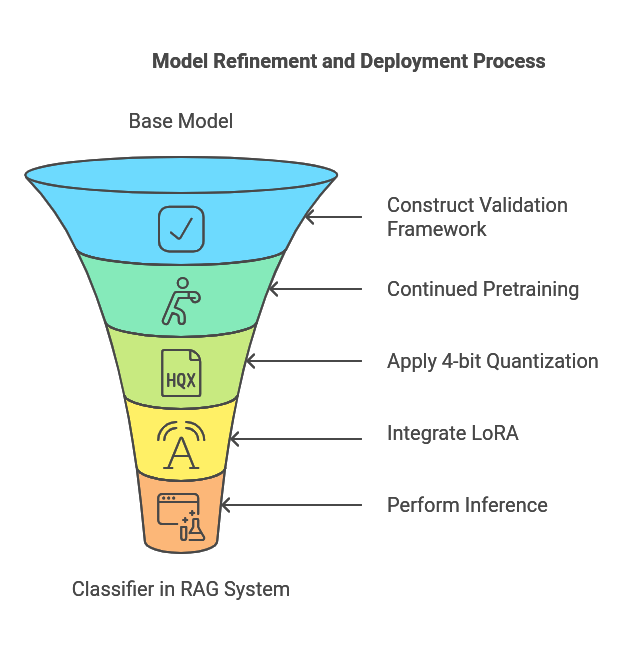library_name: transformers
tags:
- LoRA
- unsloth
license: apache-2.0
language:
- ja
base_model:
- IshiiTakahiro/llm-jp-3-13b-q-it-id2098_4bit
Model Card for Model ID
This model is a LoRA (Low-Rank Adaptation) fine-tuned version of IshiiTakahiro/llm-jp-3-13b-q-it-id2098_4bit, designed for efficient parameter updates and task-specific customization. LoRA enables lightweight fine-tuning by adapting only a subset of model parameters, significantly reducing the computational and storage requirements.
This llama model was trained 2x faster with Unsloth and Huggingface's TRL library.
Model Details
Model Architecture and Visual Abstract
Model Overview
This is a LoRA (Low-Rank Adaptation) fine-tuned version of IshiiTakahiro/llm-jp-3-13b-q-it-id2098_4bit, designed for efficient parameter updates and task-specific customization. LoRA enables lightweight fine-tuning by adapting only a subset of model parameters, significantly reducing the computational and storage requirements.
Note: The base model, "IshiiTakahiro/llm-jp-3-13b-q-it-id2098_16bit," is a further pre-trained version of "llm-jp/llm-jp-3-13b." Please be aware of this distinction.
This is the model card of a 🤗 transformers model that has been pushed on the Hub. This model card has been automatically generated.
- Base Model: IshiiTakahiro/llm-jp-3-13b-q-it-id2098_4bit
- Adaptation Type: LoRA
- Language: Japanese
- License: Apache 2.0
This model specializes in tasks such as sentiment analysis, dialogue generation, and text summarization.
Intended Use
Primary Use Cases
This LoRA model is ideal for the following tasks:
- Text Generation: Efficiently generate Japanese text for specific domains or use cases.
- Text Classification: Perform classification tasks with reduced resource consumption.
- Domain-Specific Fine-Tuning: Quickly adapt to niche tasks without retraining the entire model.
Out-of-Scope Use Cases
- This LoRA model inherits limitations from the base model and should not be used for:
- Generating harmful or biased content.
- High-stakes decision-making in legal, medical, or critical scenarios.
How to Use
Installation
Before running the code, install the required libraries:
!pip uninstall unsloth -y && pip install "unsloth[colab-new] @ git+https://github.com/unslothai/unsloth.git"
!pip install --no-deps xformers trl peft accelerate bitsandbytes jsonlines
Example Code
from unsloth import FastLanguageModel
import torch
from tqdm import tqdm
import random
import numpy as np
from multiprocessing import Pool, cpu_count
import re
import datetime
import csv
import jsonlines
from google.colab import userdata
HF_TOKEN=userdata.get('HF_TOKEN')
peft_model, tokenizer = FastLanguageModel.from_pretrained(
model_name="IshiiTakahiro/llm-jp-3-13b-it_lora",
dtype=torch.bfloat16,
load_in_4bit=False,
trust_remote_code=True,
token=HF_TOKEN,
)
def evaluate_task_score(task: str, answer: str) -> int:
return 0
def batchify(data, batch_size):
"""データをバッチに分割する関数"""
for i in range(0, len(data), batch_size):
yield data[i:i + batch_size]
def score_prediction(task_input, predictions, index):
scores = [
evaluate_task_score(task_input, prediction)
for prediction in predictions
]
# ファイルに出力
output_file = f"{ID}.prediction_scores.csv"
with open(output_file, mode="a", newline="", encoding="utf-8") as file:
writer = csv.writer(file)
for prediction, score in zip(predictions, scores):
writer.writerow([index, task_input, prediction, score])
return index, scores
datasets = []
# タスクとなるデータの読み込み。
# 事前にデータをアップロードしてください。
with jsonlines.open("./elyza-tasks-100-TV_0.jsonl", "r") as reader:
datasets = list(reader)
FastLanguageModel.for_inference(peft_model)
peft_model = peft_model.to(dtype=torch.bfloat16)
MAX_NEW_TOKENS:int = 2048
NUM_RETURN_SEQUENCES:int = 1
BATCH_SIZE:int = 1
ID:int = 1000
tasks_with_predictions = []
torch.cuda.empty_cache()
for batch in tqdm(batchify(datasets, BATCH_SIZE), desc="Running inference on GPU"):
batch_inputs = []
batch_task_ids = []
for dt in batch:
input_text = dt["input"]
annotation = f"### 注釈\n 追加情報: {random.randint(1, 100)}。この追加情報は無視してください。"
prompt = f"### 指示\n{input_text}\n{annotation}\n### 回答\n"
batch_inputs.append(prompt)
batch_task_ids.append(dt["task_id"])
inputs = tokenizer(
batch_inputs,
return_tensors="pt",
padding=True,
truncation=True
).to(peft_model.device)
with torch.no_grad():
outputs = peft_model.generate(
**inputs,
max_new_tokens=MAX_NEW_TOKENS,
use_cache=True,
do_sample=False,
repetition_penalty=1.07,
early_stopping=True,
num_return_sequences=NUM_RETURN_SEQUENCES,
pad_token_id=tokenizer.pad_token_id,
bos_token_id=tokenizer.bos_token_id,
eos_token_id=tokenizer.eos_token_id
)
batch_predictions = [
tokenizer.decode(output, skip_special_tokens=True).split('\n### 回答')[-1].strip()
for output in outputs
]
for task_id, input_text, prediction in zip(batch_task_ids, batch_inputs, batch_predictions):
tasks_with_predictions.append((task_id, input_text, [prediction]))
# CPUでのスコアリング(並列化)
def cpu_scoring(task):
task_id, task_input, predictions = task
return score_prediction(task_input, predictions, task_id)
with Pool(cpu_count()) as pool:
scoring_results = list(
tqdm(pool.imap(cpu_scoring, tasks_with_predictions), total=len(tasks_with_predictions), desc="Scoring on CPU")
)
# 最終結果の収集
results = []
for (task_id, task_input, predictions), (_, scores) in zip(tasks_with_predictions, scoring_results):
best_index = np.argmax(scores)
print("task_id:", task_id, ", best_index:", best_index)
best_prediction = predictions[best_index]
results.append({
"task_id": task_id,
"input": task_input,
"output": best_prediction
})
# 保存
output_filename = f"id{ID}.jsonl"
with jsonlines.open(output_filename, mode='w') as writer:
writer.write_all(results)
print(f"Results saved to {output_filename}")
Bias, Risks, and Limitations
This LoRA model inherits biases and risks from its base model:
- Cultural and Linguistic Bias: Outputs may reflect biases present in the Japanese-language training data.
- Domain-Specific Limitations: Performance may degrade outside of the fine-tuned domain or task.
Recommendations
- Validate outputs critically, especially when applied to sensitive domains.
- Fine-tune further or evaluate carefully when adapting this model for a new domain.
Training Procedure
This model was fine-tuned using LoRA, which updates only a small number of low-rank matrices:
Base Model: IshiiTakahiro/llm-jp-3-13b-q-it-id2098_4bit LoRA Ranks: 8 Precision: bf16 Hardware: NVIDIA L4 GPUs
LoRA significantly reduces computational overhead compared to full model fine-tuning, while maintaining performance on the target task.
Citation
If you use this model, please cite it as follows:
BibTeX:
@misc{ishii2024lora, title={LoRA Adaptation of Large Japanese Language Model}, author={Takahiro Ishii}, year={2024}, note={Available at Hugging Face Hub: https://huggingface.co/IshiiTakahiro/llm-jp-3-13b-q-it-id2098_4bit} }
